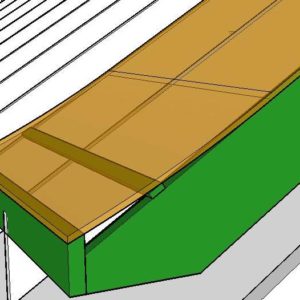I am detailing a roof edge where we want a “flip,” and by that I mean a curved flare. A real common detail in bungalows, arts and crafts designs, etc. I’ve not done a flared roof before.
The main pitch is 8:12, overhangs are a big 42″ from framing to outside face of subfascia, and the rise we want is about 2-1/4″. Just a little flip, with point of tangency about halfway up the overhang.
We could bandsaw the curve into some scabbed on tails, but I thought something else might work OK.
See the sketch here to tell us if this seems reasonable. A 2x subfascia is ripped so its top is pitched at 25 degrees, then nailed onto the rafters so the peak is up 2-1/4″ over the rafter ends. A 5/8″ furring strip goes upslope a little as a shim. The sheathing is in two thicknesses of CDX ply, and I am not sure what we will use, because everything above will be 5/8 OSB. The two lines you see in the translucent ply sheet represent about 24″ width of a 48-wide sheet.





















Replies
I love the look of a bell roof but I think that going with only a 2-1/4"
rise will be hardly noticeable.
Gene when I've done them in the past they always seem to be detailed pretty much the same way no matter who the architect is. We end up cutting curved sleepers to scab onto the rafters and then sheath as normal (with 5/8") to the start of the curve then sheath the curve itself with strapping (1x3 spruce).
In your situation I think it would be very hard to get a consistant "swoop" with the plywood. I also thing you're aiming a bit shallow. Might be hard to even notice after all that work.
We will however do something similar to what you've drawn in a vertical situation.... like at the base of 1st floor walls for the shingle siding to flair.
Thanks for the information, Brian.
I was trying to avoid the pattern-cut swoops, but it looks as if we'll need to do it if we want more raise to it.
No problem, just a little more of the forest whacked, and a couple hours in the shop at the bandsaw. We'll jack up the edge another few inches to make the belled-up edge somewhat more apparent, though still subtle.
We will box in the underside level, and plank-finish the soffit, so the sheathing will be hidden. Do you fur-sheathe solid for the starter course edge, and then skip-sheathe up from there to the top of the curve? Or do you plank it solid all the way?
I just checked, and the Red Sox are at the bottom of the east in the standings. Do they have a strategy? ;-)
View Image
"A stripe is just as real as a dadgummed flower."
Gene Davis 1920-1985
We have always sheathed solid but I can't think of a reason why you couldn't skip sheath.
As far as the Sox go.... it's the first week of the season. We'll talk again around the All-Star break. Right around the time the Yankees fire Girardi, the fans are booing A-rod again, the pitching staff is in shambles, and the talk of the town will be what a bust Texiera is. LOL.....View Image
Gene, I would recommend cutting one pattern, and using it to make duplicate components, on a shaper or router table.
In your situation I think it would be very hard to get a consistant "swoop" with the plywood. I also thing you're aiming a bit shallow. Might be hard to even notice after all that work.
Brian,
What kind of range of depth have you seen when doing such work? That is, instead of Gene's proposed 2-1/4" depth (over about two lineal feet, from what I can tell), what dimensions do you think would work well?
You know I'm not sure come to think of it...I'll see if I can dig up the plans for one we did not too long ago and check.View Image
Hi Brian,
I'd still be interested in hearing about some details on the Japanese roof when you get around to it.
Thanks!
That looks fine by me. It looks like you are planning metal roof so you want to check whether skip sheathing OK with them f=before going that way, and what the amt they can swoop that material. I suspect limits to that is why you show such a slight amt of swoop there.
For shingle siding and a swoop, I sheathe solid to frame then add shim with rips similar to the angle on your fascia.
Welcome to the
Taunton University of Knowledge FHB Campus at Breaktime.
where ...
Excellence is its own reward!
My question on these types of roof is "why"? Anyone know the functional/historic precedent for flipping up the edge?
Beauty is in the eye of the beholder.
I don't see much in the way of flared roofs, when viewing the vinyl-sided boxes of current production housing. Nor is it common in trailer parks.
There was plenty of it done, for people of means, and even for families with somewhat more modest incomes, in America's first great housing bubble, which occured in the 1920s.
It's decoration, plain and simple. Look at the pagoda roofs in China and Japan, going back to the 1300s.
View Image
"A stripe is just as real as a dadgummed flower."
Gene Davis 1920-1985
I agree that the flares look nice and show an attention to craft and detail. But every decoration ultimatly derives from a functional reason and I'm wondering what that reason is.
So the Chinese could get the tennis balls and bottle rockets out of the gutters easier.
LOL....View Image
Now it is a concession to taste, but there was once a reasoning, depending on geography and climate.The older Japanese way of framing a roof ended up creating this. It was a sort of what I'd describe as a woven post and beam structure that was able to handle earthquakes regularly.In some European and New England homes, the lower pitch at bottom (not always a smooth curve either) was so that snow cascading would hit a brake and not kill as many people or remove as many gutters.
Welcome to the Taunton University of Knowledge FHB Campus at Breaktime. where ... Excellence is its own reward!
My question on these types of roof is "why"? Anyone know the functional/historic precedent for flipping up the edge?
I think you're right in assuming there was a functional reason for the flared roof line (in addition to style alone). My understanding is that it was a way to execute a heavy eave without obscuring the windows.
Where I live, for example, I see a significant number of flared roofs (aka Japanese roofs) on houses built around 1905. Those same houses typically have 30"-36" eaves. On an 8/12 main roof, that would translate to a drop of about 20" - 24" (8*2.5' to 8*3') from the top plates. Since the window heads were typically only 12" down, that would obviously obscure the windows; it would be impossible to execute if the eaves were soffited.
On the grander mansions, the eaves were sometimes four or five feet!
I really like the look of the Japanese roof, but have yet to get a chance to tear into one to see how it was originally detailed.
Edited 4/21/2009 3:13 pm ET by Ragnar17
I'm not going to be of any help to anyone here, but the talk of Japanese roofs made me think of some photos I took during by trip to Japan last fall.
Very cool. Thanks for sharing. You reckon they did all that with push saws?http://www.quittintime.com/ View Image
I framed this house sort of the same way you're suggesting. I started higher up with 2x4's on the flat then dbl'd them up at the bottom if I recall correctly....as you can see the gambrel sides don't show the flare all that much but for me...it was just enough. I like Brians way for your purposes.
http://www.cliffordrenovations.com
http://www.ramdass.org
Just did this on one of my jobs with 3/4" plywood sheathing and 2 layers of 3/8" at the eave curve - that worked out very nicely (Vermont unfading green with purple accents).
Jeff
The traditional 'habitant' Quebec farmhouse roofline is belled with either a 12:12 gable or a gambrel (the two most common). It's curved with coyau pieces--scabbed on sleepers--and when I do it I just saw them out of 2x framing stock hewing to a pencil line with a bandsaw or jig saw. Pattern cutting them on a big shaper would work, but that takes longer and there really isn't any need for that kind of precision as the sheathing fairs out any differences in cut from one to the next pretty effectively.
On smaller buildings, I'll sheath with 1x4 or 1x6 plank stock (depending on the radius of the curve); on bigger ones we kerf the top of 3/8" or 1/2" ply, force it in place with a couple of guys standing on it, and nail it down every 3" throughout the curved area.
Here's a photo of my crew installing the sheathing on the curve at the bottom of a gambrel flaring out into a 6' deep porch roof. You can see the coyau bridging the two sets of rafters.
View Image
BTW, the functional reason for the curved roof (in this area, anyway) was to create small whirlwinds that would build up a nice, big wind-drift of snow right in the curve--which was always located right over the joint between the roof and the building wall, one of the weak points in the heat envelope. The idea was to collect a thick layer of snow there to help trap heat in the house in the days before insulation was invented.
The old habitants would shovel snow right up to the eaves against the outside walls of the house, too, for the same reason. Think of a wood-lined igloo, sorta....
Dinosaur
How now, Mighty Sauron, that thou art not brought
low by this? For thine evil pales before that which
foolish men call Justice....